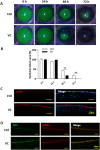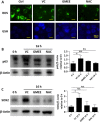Ascorbic Acid Promotes the Stemness of Corneal Epithelial Stem/Progenitor Cells and Accelerates Epithelial Wound Healing in the Cornea
- PMID: 28276172
- PMCID: PMC5442716
- DOI: 10.1002/sctm.16-0441
Ascorbic Acid Promotes the Stemness of Corneal Epithelial Stem/Progenitor Cells and Accelerates Epithelial Wound Healing in the Cornea
Abstract
High concentration of ascorbic acid (vitamin C) has been found in corneal epithelium of various species. However, the specific functions and mechanisms of ascorbic acid in the repair of corneal epithelium are not clear. In this study, it was found that ascorbic acid accelerates corneal epithelial wound healing in vivo in mouse. In addition, ascorbic acid enhanced the stemness of cultured mouse corneal epithelial stem/progenitor cells (TKE2) in vitro, as shown by elevated clone formation ability and increased expression of stemness markers (especially p63 and SOX2). The contribution of ascorbic acid on the stemness enhancement was not dependent on the promotion of Akt phosphorylation, as concluded by using Akt inhibitor, nor was the stemness found to be dependent on the regulation of oxidative stress, as seen by the use of two other antioxidants (GMEE and NAC). However, ascorbic acid was found to promote extracellular matrix (ECM) production, and by using two collagen synthesis inhibitors (AzC and CIS), the increased expression of p63 and SOX2 by ascorbic acid was decreased by around 50%, showing that the increased stemness by ascorbic acid can be attributed to its regulation of ECM components. Moreover, the expression of p63 and SOX2 was elevated when TKE2 cells were cultured on collagen I coated plates, a situation that mimics the in vivo situation as collagen I is the main component in the corneal stroma. This study shows direct therapeutic benefits of ascorbic acid on corneal epithelial wound healing and provides new insights into the mechanisms involved. Stem Cells Translational Medicine 2017;6:1356-1365.
Keywords: Colony formation; Microenvironment; Proliferation; Stem cell-microenvironment interactions; Stem/progenitor cell; Tissue regeneration.
© 2017 The Authors Stem Cells Translational Medicine published by Wiley Periodicals, Inc. on behalf of AlphaMed Press.
Figures





References
-
- Blanchard J, Tozer TN, Rowland M. Pharmacokinetic perspectives on megadoses of ascorbic acid. Am J Clin Nutr 1997;66:1165–1171. - PubMed
-
- Ichibe Y, Ishikawa S. [Optic neuritis and vitamin C]. Nippon Ganka Gakkai zasshi 1996;100:381–387. - PubMed
-
- Vitetta L, Sali A, Paspaliaris B et al. Megadose vitamin C in treatment of the common cold: A randomised controlled trial. Med J Aust 2002;176:298–299. - PubMed
-
- Iqbal Z, Midgley JM, Watson DG et al. Effect of oral administration of vitamin C on human aqueous humor ascorbate concentration. Zhongguo Yao Li Xue Bao 1999;20:879–883. - PubMed
-
- Savini I, Rossi A, Pierro C et al. SVCT1 and SVCT2: Key proteins for vitamin C uptake. Amino acids 2008;34:347–355. - PubMed
Publication types
MeSH terms
Substances
LinkOut - more resources
Full Text Sources
Other Literature Sources
Medical

